Exploring the Life Cycle of a Flea: From Egg to Adult
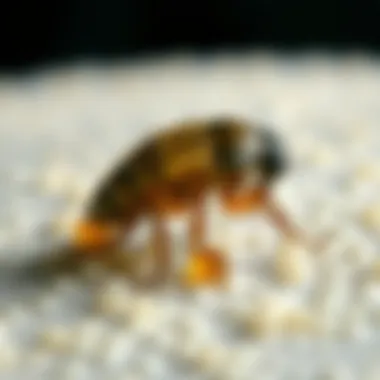
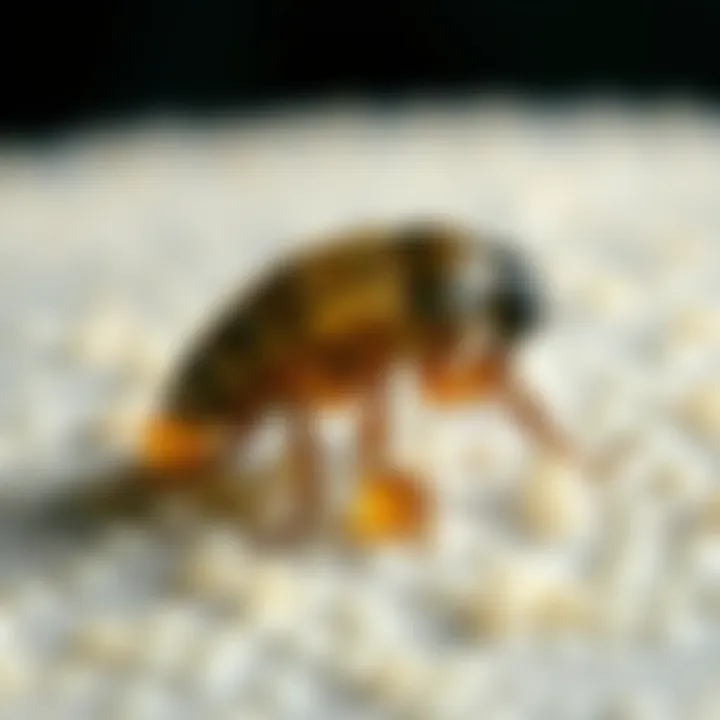
Intro
Fleas may seem like mere nuisances, but their life cycle is a fascinating and complex affair. Understanding it not only sheds light on their biological intricacies but also reveals how we can manage their populations effectively. From the moment an egg is laid to the emergence of a fully-grown flea, each stage of life is intricately tied to environmental factors, necessitating a keen awareness of their habits and habitat.
As we embark on this exploration, we will dissect the life cycle of fleas, examining the interplay between their life stages and our surroundings. Along the way, we will also discuss the implications for pest control strategies and preventive measures, arming housewives and homeowners with practical knowledge to combat infestations. After all, when it comes to these little pests, knowledge is power.
Understanding Pests
Definition of Pests
In the simplest terms, pests are organisms that can cause damage or interfere with human activities. They often disrupt our daily lives, whether they're gnawing on our beloved pets or invading our homes. Fleas are certainly among the most notorious of these. The term 'pest' isn't just a label; it encapsulates the relationship between the organism and us. In the case of fleas, their ability to reproduce rapidly and adapt to different environments makes them particularly troublesome.
Importance of Pest Identification
Identifying pests correctly is the first step towards effective management. While fleas are small, their impact can be substantial. They can affect both health and comfort, causing skin irritations and allergic reactions in pets and humans alike. Moreover, knowing their specific characteristics, like appearance and behavior, can aid in deciding proper elimination strategies. For instance, did you know that an adult flea can leap up to 200 times its body length? This ability to jump makes them quite adept at evading attempts to remove them.
"Understanding flea biology opens up avenues for effective interventions, transforming a frustrating problem into a manageable one."
Prevention Techniques
Home and Garden Preventative Measures
Implementing preventative strategies is crucial in keeping fleas at bay. In your home, simple tactics can include:
- Regularly vacuuming carpets, rugs, and upholstery.
- Washing pet bedding and soft furnishings in hot water.
- Sealing any pet food in airtight containers to avoid attracting pests.
Taking steps outside the home is equally important. Keeping your garden tidy and trimming tall grasses can eliminate potential flea breeding grounds. You can also deploy natural barriers like diatomaceous earth, which helps to deter pests.
Seasonal Prevention Tips
Different seasons call for tailored strategies. During warmer months, when flea populations explode, more frequent vacuuming and pet grooming may be necessary. On the other hand, in colder periods, consider checking for any cracks or gaps in doors and windows where fleas may try to sneak in from outside.
Eco-Friendly Pest Control Solutions
Overview of Sustainable Practices
When it comes to controlling fleas, eco-friendly solutions are becoming ever more popular. Not only do they help keep your home chemical-free, but they are also safer for pets and humans. Techniques such as using beneficial nematodes or introducing flea-repellent plants like rosemary can be effective in managing flea populations.
Natural Remedies and Their Effectiveness
There are a variety of natural remedies that may help mitigate flea issues:
- Apple cider vinegar: mixed with water can create a spray that repels fleas.
- Lemon spray: boiling lemon peels in water creates a natural deterrent.
- Essential oils: such as lavender or peppermint, can effectively repel fleas when diluted properly.
Natural solutions may not eradicate an infestation entirely, but they can significantly reduce flea numbers and help maintain a more comfortable living environment.
As we continue to unravel the stages of the flea life cycle in further sections, these foundational practices will be crucial in creating an effective strategy for managing them effectively.
Foreword to Fleas
Understanding fleas and their life cycle is pivotal, not just for those who own pets but also for anyone concerned about pest management in their living spaces. Fleas are tiny, wingless insects that reside on animals and in their environments, and guess what? They’re far more than just a nuisance. They can transmit diseases and induce serious discomfort in both pets and humans. So, getting to grips with their lifecycle offers insights that can aid in effective management and control strategies.
Definition and Characteristics of Fleas
Fleas belong to the order Siphonaptera, and their physical characteristics can be both fascinating and alarming. Usually measuring around 1 to 3 mm, these little critters are flattened laterally, which makes it easy for them to navigate through their hosts’ fur or feathers. They have long hind legs which enable them to jump with astonishing strength; a flea can jump about 200 times its own body length. These adaptations are not just nifty tricks; they are essential for their survival and dispersal.
In terms of coloration, fleas often sport a brown or black hue, giving them a somewhat menacing appearance. One notable feature is their mouthparts, which are perfectly designed for piercing skin and drawing blood. This behavior not only sustains the flea but also poses a risk of transmitting parasites and pathogens.
Ecological Role of Fleas
While fleas are often seen solely as pests, they do play a role in the ecosystem. They are a food source for various animals, including birds and small mammals. In a balanced ecosystem, their presence can support local wildlife. However, when their population swells, the negative impacts become apparent.
Fleas help control other hosts’ populations by consuming their blood; in doing so, they can indirectly affect the overall health of the host species. In domestic settings, however, this ecological role often causes more trouble than it’s worth, leading to infestations and requiring homeowners to engage in pest control methods.
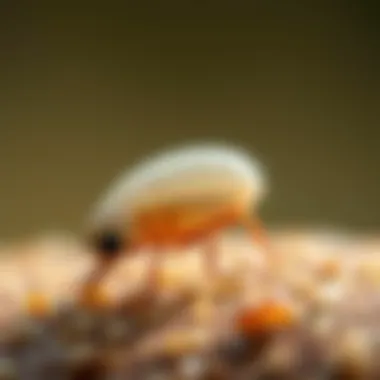
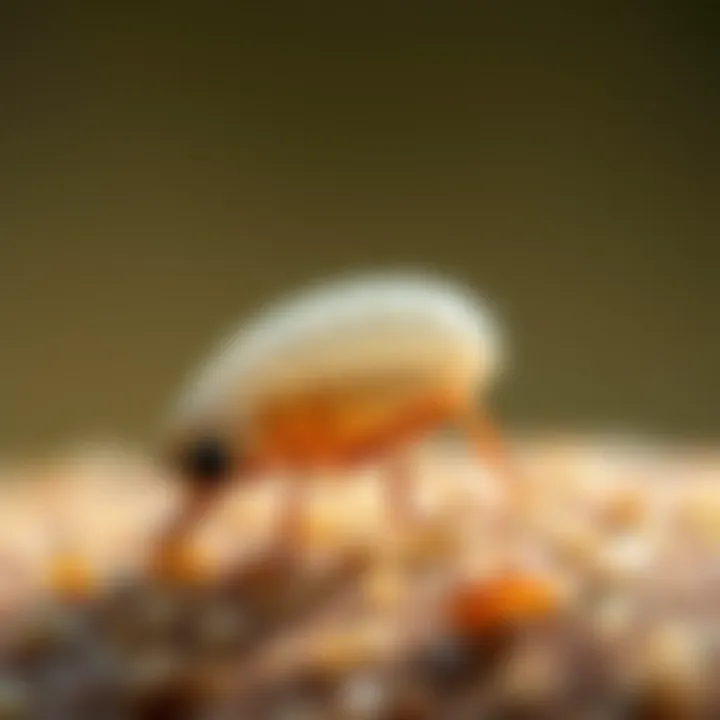
In summary, comprehending fleas' definition and their ecological context lays a solid foundation for exploring their life cycle. This understanding not only informs homeowners about potential impacts but also emphasizes the importance of managing their populations proactively.
Overview of the Flea Life Cycle
Understanding the life cycle of a flea is fundamental for homeowners and pet owners alike. Fleas are not just a nuisance; they can cause discomfort to pets and potentially spread various diseases. By grasping the stages of their development, one can better appreciate how to effectively manage and control these pests. The life cycle of fleas unfolds in different phases, each presenting unique traits and challenges that can influence infestation severity.
Stages of Development
Fleas undergo a remarkable transformation throughout their existence, commonly divided into four key stages: Egg, Larval, Pupal, and Adult. Each stage has distinct characteristics and plays a pivotal role in the overall flea life cycle.
Egg Stage
The initial phase of a flea's life begins when adult fleas lay their eggs. These eggs are tiny, about 0.5 mm in size, resembling small white grains. One notable characteristic of flea eggs is their smooth surface, making them prone to falling off their hosts into the environment. This characteristic is crucial since it promotes proliferation; when you see that little white speck, that's a future flea ready to hatch.
A beneficial feature of the egg stage is its rapid development time. Eggs can hatch within two days to two weeks, depending on environmental conditions, such as temperature and humidity. However, they have the disadvantage of being vulnerable to insecticides and other environmental factors. The egg stage is instrumental in understanding how quickly infestations can occur, so it's essential for homeowners to maintain cleanliness to disrupt this cycle.
Laval Stage
Once hatched, fleas enter the larval stage, where they are elongated and resemble tiny maggots. The main contribution of this stage is the feeding habits, as larval fleas thrive on organic debris found in carpets, bedding, and pet dander. This feeding behavior highlights the necessity of proper sanitation in pet areas.
Interestingly, larval fleas possess the key characteristic of being photophobic and prefer the dark. This unique feature allows them to remain hidden from light and potential threats, increasing their chances of survival.
However, this stage does come with some disadvantages. Larval fleas are dependent on their environment. A too-dry environment can lead to higher mortality rates. Therefore, homeowners should focus on maintaining a clean but slightly humid environment to support the larval fleas' growth while preventing them from reaching adulthood.
Pupal Stage
As they mature, larvae spin cocoons, transitioning into the pupal stage, which can last from a few days to several months. A significant aspect of this stage is the pupae's resilience; they can withstand various environmental challenges, including insecticides. This resilient cocoon allows fleas to endure unfavorable conditions until they sense the right moment to emerge, typically triggered by vibrations, heat, and carbon dioxide from potential hosts.
The pupa's unique characteristic of dormancy is advantageous for the species. It acts as a survival strategy, giving adults time to wait until conditions are more suitable for their development. Conversely, the duration can be a disadvantage for homeowners, as it adds to the difficulty of controlling infestations.
Adult Stage
The life of an adult flea begins when it emerges from its cocoon, ready to seek a host for blood feeding. Adult fleas are small, brownish-black, and known for their remarkable jumping ability—up to 150 times their body length. This key characteristic ensures they find hosts effectively, making them a persistent nuisance.
Additionally, adult fleas are known for their ability to reproduce rapidly. A female flea can lay up to 50 eggs daily, leading to exponential growth in populations if left unchecked. This rapid reproductive capacity emphasizes the importance of early intervention in flea control. However, adult fleas also rely heavily on their host animals for survival, making them vulnerable to treatments aimed at pets.
Duration of Each Life Stage
The timeline for each stage varies based on environmental factors. Generally, fleas can complete their life cycle from egg to adult in as few as three weeks but can take much longer if conditions are less than ideal. For homeowners, understanding these durations is key to effective management. Environmental factors such as temperature and humidity play a significant role in the lifecycle's speed. Warmer, humid conditions favor faster development, whereas cooler and dryer settings inhibit progress.
Egg Stage
The egg stage of a flea's life is the crucial starting point, offering a fascinating glimpse into the complex biological landscape of these pests. Fleas, while often regarded as mere nuisances, begin their journey as tiny, unassuming eggs that can easily go unnoticed. Understanding this stage is essential for anyone looking to manage flea populations effectively in their homes.
Characteristics of Flea Eggs
Flea eggs are small and oval in shape, measuring about 0.5 mm long. They are typically white or translucent, making them difficult to spot against various surfaces. One of the most interesting aspects of flea eggs is their smooth texture, which helps them to slip into tight crevices and hidden spaces in carpets and upholstery—ideal for their survival. Unlike some insects, flea eggs do not stick to surfaces very well. This lack of adherence means they often end up in places where the adult fleas frequent or where the host animals sleep.
"Flea eggs are as elusive as a shadow, blending in with the world around them, hiding from the untrained eye."
Moreover, a female flea can lay a staggering amount of eggs, from 20 to 50 per day after a blood meal, leading to a rapid accumulation of eggs in infested environments. The sheer quantity underscores the importance of timely intervention for pest control. The eggs remain dormant until environmental conditions are favorable for their development.
Environmental Factors Influencing Egg Development
The development of flea eggs hinges significantly on environmental factors, primarily temperature and humidity. Flea eggs thrive in warm and humid settings, with the ideal conditions being around 70 to 85 degrees Fahrenheit (21 to 29 degrees Celsius) and high humidity levels, generally above 50%. These conditions can be commonly found in households, especially in areas like living rooms and pet resting spots, making it easier for a flea infestation to take hold.
Additionally, light exposure plays a role in the health of flea eggs. While they may initially sit precariously in shadowy corners, they respond well to light and warmth, which stimulate their development and eventual hatching.
- Key Factors for Flea Egg Development:
- Temperature: Warmth encourages growth.
- Humidity: Higher moisture leads to quicker hatching.
- Light: Exposure can influence their metamorphosis process.
Proper management of these environmental conditions is essential for homeowners. Reducing humidity through dehumidifiers and maintaining a consistent temperature can help to hinder growth, making it less likely for flea populations to bloom into a full-blown infestation. By staying ahead of these factors during the egg stage, homeowners increase their chances of controlling these persistent pests before they can reach adulthood.
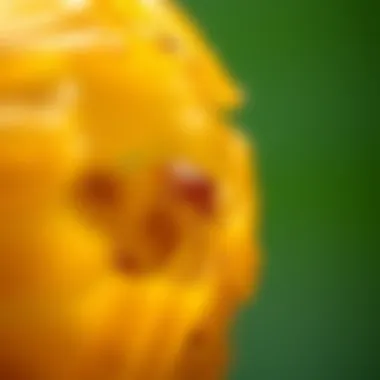
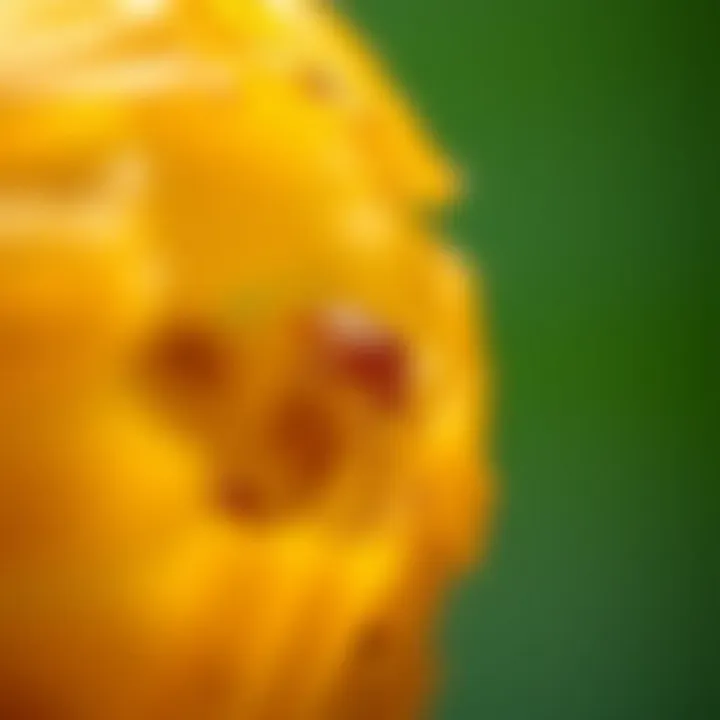
Laval Stage
The laval stage marks a critical point in the life cycle of a flea, serving as the transitional phase between egg and adulthood. This journey transforms a tiny egg into a more recognizable form, setting the stage for what's to come in terms of growth and reproduction. It’s essential to understand this stage not just for awareness, but also for managing infestations effectively in your home environment.
Description of Larval Fleas
When fleas hatch from their eggs, they emerge as larvae that are distinctly different from their adult counterparts. Measuring roughly 2 to 5 mm in length, these larvae are slender, typically covered with tiny hairs, and exhibit a pale white or cream color. What stands out, however, is their lack of eyes and wings. Instead, larval fleas depend heavily on their tactile senses to navigate their environment. This stage is crucial because it indicates the flea's adaptability: they can thrive in various habitats, whether under carpets or in pet bedding— essentially wherever they can find sufficient warmth and organic debris.
Feeding Habits and Diet
Larval fleas are not picky eaters; in fact, they feast on organic matter. Their diet is primarily composed of:
- Flea feces: The excrement of adult fleas, known commonly as "flea dirt," is a rich source of protein for emerging larvae.
- Skin flakes: Any shed skin from pets or humans becomes a veritable buffet for these pests.
- Other organic debris: This can include dust, hair, and even mold, which provide the nutrients necessary for their growth.
In this stage, effective diet is pivotal for their development into pupae, and thus ensuring a robust life cycle. If conditions are unfavorable, lethargy can set in, leading to stunted growth or even death.
Survival and Growth Factors
The survival and growth of larval fleas hinge on a mix of environmental and biological factors:
- Humidity & Temperature: The ideal humidity level should be between 50-70%. Temperatures ideally hover around 70-95°F (21-35°C). Too low of a temperature can slow down their development.
- Food Availability: Without adequate food supply, larval fleas may not survive to adulthood. The abundance of flea dirt ensures sustenance in infested environments.
- Predation and Competition: While larvae have a degree of protection in their environment, they are susceptible to predation by other insects and even small animals. Competition for food can also impact their survival rate.
Understanding these factors provides key insights into prevention strategies, as adjusting the environment may limit larval development and effectively manage flea populations.
In summary, the larval stage of fleas is a determining factor in their successful life cycle. Recognizing the characteristics, feeding habits, and growth requirements not only sheds light on their biology but also equips homeowners with the knowledge necessary for pest management. For further insights and resources on flea behavior and effective control strategies, one can explore CDC, EPA, and various relevant educational articles.
Pupal Stage
The pupal stage is a crucial transition in the life cycle of fleas, serving as a bridge between their larval phase and adulthood. This stage is often likened to a kind of sleep, where the flea undergoes significant changes to emerge as a fully formed adult. Understanding this phase is important for various reasons, particularly in managing flea infestations.
Transformation into Pupae
Every larva goes through a remarkable metamorphosis as it transforms into a pupa. This process begins when the larva senses suitable environmental conditions, triggering it to spin a silken cocoon, providing a safe haven while it completes its transformation. Within this cocoon, the larval structures break down and re-form into the recognizable adult anatomy, including mouthparts, legs, and reproductive organs. While the pupa is not entirely inactive, it enters a state of dormancy that can last from several days to several months, depending on various factors.
The pupae can withstand significant environmental changes, making them resilient to pest control measures. For instance, they can resist extreme temperatures and even chemical treatments. Hence, identifying and targeting this stage is essential for effective flea management strategies.
Duration and Conditions for Development
The duration of the pupal stage can vary greatly, often influenced by environmental factors such as humidity, temperature, and the availability of hosts. Typically, this stage lasts anywhere from one to two weeks, but it can extend up to several months under unfavorable conditions.
In warmer climates, pupae tend to develop more quickly. Humidity also plays a vital role; a damp environment can spur development, while dry conditions may delay this crucial transformation.
It's essential to understand that once the adult flea is fully formed within the cocoon, it requires a host to emerge. This host-seeking behavior often means that adult fleas can remain dormant within their cocoons, waiting for the right moment to break free and infest a nearby pet or human.
"Flea pupae exhibit remarkable durability, often lying in wait until conditions are just right for their survival and proliferation."
In summary, the pupal stage is not just a waiting period; it's a pivotal moment filled with transformation and potential. Recognizing the characteristics and duration of this phase can significantly enhance proactive management efforts to keep fleas at bay.
Adult Stage
The adult stage of fleas marks the final chapter in the life cycle of these notorious pests. This stage is crucial as it is the phase where fleas take on their characteristic form, engage in reproduction, and multiply their population, which can lead to significant infestations if not managed properly. Understanding adult fleas is essential for homeowners and pest management professionals alike to devise effective control strategies.
Physical Characteristics of Adult Fleas
Adult fleas are small, agile insects, typically measuring between 1.5 to 3.3 mm in length. They possess a flattened body that aids in maneuverability through fur or feathers of their hosts, making it difficult to dislodge them. Their legs are long and powerful, enabling them to jump up to 150 times their body length, which is quite a feat in the world of insects. This ability to leap is primarily used for finding hosts, and it is one of the key adaptations that contribute to their persistence.
Adults are usually brownish to black in color, with a hard outer shell that offers protection against environmental stresses. Their mouthparts are specially adapted for piercing skin and sucking blood, essential for their survival and reproductive success.
Some notable features include:
- Antennal Structure: They possess long antennae which help them sense moisture and carbon dioxide, indicating a potential host nearby.
- Combs and Bristles: Fleas have comb-like structures on their bodies known as "genal and pronotal combs" which assist in clinging onto animal hosts.
- Genitalia: The male and female fleas exhibit distinct external genital features which can be useful for understanding species differentiation.
Mating and Reproduction
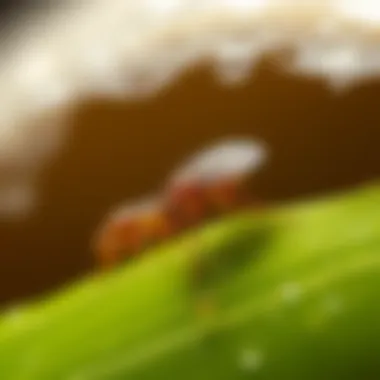
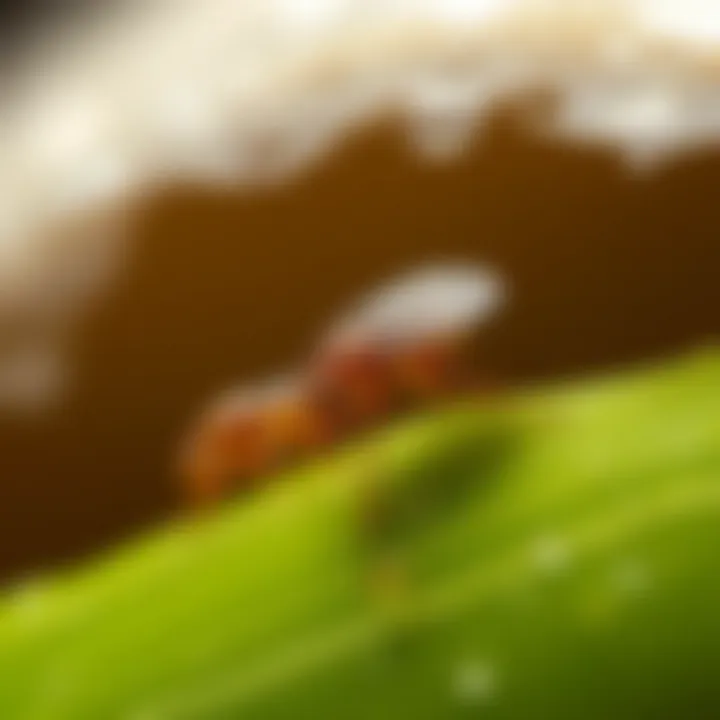
The mating behavior of fleas is quite fascinating and plays a pivotal role in their life cycle. Following adoption of the adult form, fleas are usually ready to mate within just a few days of emerging from the pupal stage. Males will often engage in competitive displays to attract females, which can include jumping and posturing.
Once mating occurs, female fleas can begin laying eggs shortly thereafter. A single female flea is quite prolific; she can lay anywhere from 20 to 50 eggs per day, which can accumulate rapidly in a home environment. This is why an infestation can spiral out of control in just a matter of weeks.
Factors Influencing Mating and Reproduction:
- Environmental Conditions: Temperature and humidity play significant roles in reproduction rates; warmer, more humid environments enhance survival of eggs and larvae.
- Host Availability: The presence of suitable hosts is crucial, as fleas derive their sustenance from the blood of these animals.
It's essential for homeowners to understand these dynamics because preventing an infestation requires a proactive approach to control not only adult fleas but also their eggs and larvae as well. Regular cleaning, vacuuming, and the use of targeted insecticides can help manage and minimize the breeding opportunities for fleas in the household. In addition, breaking the cycle of their reproduction is key to long-term control.
Life Cycle Duration
Understanding the life cycle duration of fleas reveals essential insights into their management and control. Fleas progress through a distinct series of stages which can vary in duration based on multiple factors. Knowledge about how long it takes for a flea to develop from an egg into an adult can significantly influence approaches toward infestation issues, the timing of preventive measures, and application of treatment methods. When one knows how long it typically takes for fleas to mature, they can make informed decisions on how best to address an infestation and avoid repeat occurrences.
Average Duration from Egg to Adult
Flea development can seem a bit like a puzzling maze, but at its core, the time from egg to adult ranges from a few weeks to several months. On average, one can expect the entire process to take about three to six weeks under favorable conditions. However, the variability in this period is important to recognize.
- Egg Stage: After a female flea lays eggs, typically in the host’s fur, these eggs can hatch within two days to two weeks, depending on the environmental settings. This rapidity is why a flea problem can escalate quite fast in homes.
- Larval Stage: Once they hatch, flea larvae reside in hidden areas, consuming organic matter like flea feces. This stage can last about one to two weeks.
- Pupal Stage: Fleas spin cocoons and enter a pupal phase, lasting as short as one week or extending up to several months. Pupal duration often depends on environmental cues such as temperature and humidity.
- Adult Stage: Once the conditions are right, adult fleas emerge, ready to find a host. They can live for several months to even a year, especially under prime conditions.
Impact of Environmental Conditions on Development Time
Environmental factors play a crucial role in determining how fast fleas progress through their life stages. Key elements include:
- Temperature: Warmer climates generally accelerate flea development. Fleas thrive in temperatures around 70 to 85 degrees Fahrenheit (21 to 29 degrees Celsius). In cooler settings, growth may slow, extending the life cycle.
- Humidity: Fleas prefer a relatively high humidity level. Drier conditions can lead to longer development times or even die-off, particularly in the egg and larval stages.
- Food Availability: In the larval stage, the lack of nutritional sources like flea waste can significantly prolong growth. Inspecting your pets and home, ensuring they are well taken care of, can impact flea populations.
In summary, grasping the life cycle duration of fleas alongside the environmental influences allows for a more strategic approach to flea management. It’s vital to manage not just the adult fleas but also the entire life cycle to mitigate future problems.
"Understanding the timescales involved with flea development can provide a roadmap for effective pest control measures."
For further reading on fleas and their development characteristics, check Wikipedia or the National Pesticide Information Retrieval System.
Flea Infestation and Management
Understanding flea infestations is crucial, not just for the health of your pets but also for the comfort of your household. Fleas can cause irritation and health issues, and an infestation can quickly spiral out of control. This section discusses how to identify flea infestations, effective preventive measures, and control methods to manage these pesky pests effectively.
Identifying Infestations
Fleas are sneaky little devils that can hitch a ride into your home without you even knowing it. So, the first step in managing flea infestations is recognizing the signs. Here are some key indicators:
- Flea Dirt: These are tiny black specks, which might look like pepper, found on pet bedding, carpets, or floors. If you see this, it’s a good sign that you have fleas.
- Scratching and Biting: If your pets are scratching a lot, it might mean fleas have moved in. Watch for excessive grooming as well.
- Visible Fleas: Examine your pet's fur carefully; you might see adult fleas jumping around. Use a fine-tooth comb to sift through their fur.
"Prevention is always better than cure, especially when it comes to flea infestations."
Preventive Measures
When it comes to keeping fleas at bay, prevention is often a lot easier than you might think. Here are several steps to take:
- Regular Grooming: Keeping your pets groomed can help spot any flea activity before it becomes a problem. Use flea combs or brushes designed for flea control.
- Vacuuming: Regularly vacuuming your carpets, rugs, and upholstery can help remove flea eggs, larvae, and adults. Make sure to dispose of the vacuum bag or clean the canister after each use to avoid reinfestation.
- Washing Bedding: Wash your pet's bedding in hot water regularly. This simple action eliminates flea eggs and larvae that may be hiding.
- Treating the Environment: Use flea sprays or foggers appropriate for household use and follow the instructions carefully for maximum effectiveness.
Effective Control Methods
In case you find yourself battling an existing infestation, it’s crucial to act quickly. Here are some effective ways to manage and eliminate fleas:
- Topical Treatments: Many products, like Frontline or Advantage, are available for cats and dogs. These treatments are applied directly to the skin and can kill fleas and their eggs for weeks.
- Oral Medications: Flea pills like Capstar can kill adult fleas within hours. It's often used in conjunction with topical treatments for best results.
- Professional Pest Control: If your efforts seem futile, it may be time to call in the experts. Professional exterminators have access to stronger treatments that can effectively eliminate fleas from your home.
- Seasonal Treatments: Fleas can thrive in warmer weather, so consider a seasonal approach to preventative treatments during peak flea seasons.
By closely monitoring for any signs of flea infestations and implementing preventive measures, homeowners can maintain a comfortable living environment free from these unwanted pests. When things get out of hand, be ready to take decisive action. A combination of preventative and control methods will often do the trick to reclaim your space from fleas.
Closure
Understanding the life cycle of fleas is not merely an academic exercise; it’s a crucial element for any homeowner aiming to maintain a pest-free environment. Fleas, often underestimated, can wreak havoc not just on pets, but also on the quality of life within a house. By recognizing the stages of development—egg, larva, pupa, and adult—homeowners are better equipped to tackle infestations before they spiral out of control. Each stage presents unique challenges and needs, reminding us that thorough knowledge can make all the difference when it comes to effective pest management.
Summary of Key Points
- The flea life cycle consists of four primary stages: egg, larva, pupa, and adult.
- Environmental conditions, including humidity and temperature, play a significant role in the time it takes for fleas to progress through these stages.
- Identifying flea infestations early can prevent significant discomfort for both pets and humans.
- Proactive measures, such as maintaining cleanliness and using preventive treatments, can greatly reduce the chances of an infestation.
- Understanding the biological makeup and reproductive strategies of fleas aids in developing more effective control methods.
Final Thoughts on Flea Control
Flea control is a multi-faceted approach that begins with understanding the pest itself. Homeowners should not overlook the importance of addressing not just adult fleas but also their offspring throughout the life cycle. Preventive steps e.g., regular vacuuming, washing pet bedding, and using flea treatments, should be commonplace in households with pets. Investing time to comprehend the life stages of fleas will lead to better pest management strategies and peace of mind.
"An ounce of prevention is worth a pound of cure." This old saying holds especially true in the context of flea management. It's far easier to prevent infestations than to eradicate them.



